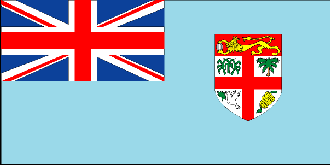
|
Fiji
Background:
Fiji became independent in 1970, after nearly a century as a
British colony. Democratic rule was interrupted by two military coups in 1987,
caused by concern over a government perceived as dominated by the Indian
community. Free and peaceful elections in 1999 resulted in a
government led by an Indo-Fijian, but a coup in May of 2000 ushered in a
prolonged period of political turmoil.
Location:
Oceania, island group in the South Pacific Ocean, about two-thirds of the way
from Hawaii to New Zealand.
Area: Total: 18,270 sq km.
Area - comparative: Slightly smaller than New Jersey.
Coastline: 1,129 km.
Climate and Terrain:
Climate: Tropical marine; only slight seasonal temperature variation.
Terrain: Mostly mountains of volcanic origin.
Elevation extremes: Lowest point: Pacific Ocean 0 m, highest point: Tomanivi
1,324 m.
Natural resources: Timber, fish, gold, copper, offshore oil potential,
hydropower.
Land use: Arable land: 10%, forests and woodland: 65%.
People:
Population: 844,330.
Ethnic groups: Fijian 51% (predominantly Melanesian with a Polynesian
admixture), Indian 44%, European, other Pacific Islanders, overseas Chinese,
and other 5%.
Religions: Christian 52%, Hindu 38%, Muslim 8%, other 2% note: Fijians are
mainly Christian, Indians are Hindu, and
there is a Muslim minority.
Languages: English (official), Fijian, Hindustani.
Government:
Government type: Republic; note: military coup leader Maj. Gen. Sitiveni
Rabuka formally declared Fiji a republic on 6 October 1987.
Capital: Suva.
Economy overview:
Fiji, endowed with forest, mineral, and fish resources, is
one of the most developed of the Pacific island economies, though still with a
large subsistence sector. Sugar exports and a growing tourist industry are the
major sources of foreign exchange. Sugar processing makes up one-third of
industrial activity. Roughly 300,000 tourists visit each year, including
thousands of Americans following the start of regularly scheduled non-stop air
service from Los Angeles. The political turmoil in Fiji has
had a severe impact with the economy shrinking by 8% in 1999 and over 7,000
people losing their jobs.
GDP - composition by sector: Agriculture: 16%, industry: 30%, services: 54%.
Labor force - by occupation: Subsistence agriculture 67%, wage earners 18%,
salary earners 15%.
Industries: Tourism, sugar, clothing, copra, gold, silver, lumber, small
cottage industries
Agriculture - products: Sugarcane, coconuts, cassava (tapioca), rice, sweet
potatoes, bananas; cattle, pigs, horses, goats; fish
Statistics:
Telephones - main lines in use: 72,000.
Telephones - mobile cellular: 5,200.
Radio broadcast stations: AM 13, FM 40.
Radios: 500,000.
Televisions: 21,000.
Internet users: 7,500.
Railways: Total: 597 km.
Highways: Total: 3,440 km, paved: 1,692 km, unpaved: 1,748 km.
Airports - with paved runways: 3, with unpaved runways: 24.
Return to Visiting Locations
|

